If you’re not using WordPress dynamic content on your website or blog, you’re missing out! 🤓
Dynamic content is a great way to keep your site fresh and engaging, and it can help you attract new readers and followers.
Best of all, dynamic content in WordPress no longer requires technical knowledge. You can find some great WordPress dynamic content plugins that let you work with it without actually knowing how to code.
What is WordPress dynamic content? Why do you need it?
With WordPress dynamic content, you can insert content from your site’s database. That could be core WordPress content (e.g., a post’s publish date) or content from custom fields that you’ve added with a plugin like Advanced Custom Fields.
By learning how to use dynamic content, you can build more complex, easily manageable websites.
👉 For example, let’s say you write a lot about a product and you reference that product’s price in different parts of your site:
- With static content, you would just write the price in plain text. If the product’s price ever changes, you would need to go in and manually update every reference.
- With dynamic content, you could pull in the product’s price dynamically. That way, you can just update the product’s price one time and that change will automatically apply to every reference.
Beyond simplifying your own workflows, you can also use dynamic content to build custom content sites.
For example, let’s say you want to build a job post listing site. You could create a custom post type to store each job, including custom fields for the salary, start date, and so on.
Then, you could use dynamic content to pull in all those custom details on the frontend of your site.
🧰 With the right tools, you can even set up these types of dynamic content use cases without needing any code.
How to add dynamic content to your WordPress site
If you’re looking to add dynamic content to your WordPress site, there are a few ways to go about it.
One option is to add dynamic content manually by editing your WordPress code. This is an advanced option, and it’s not recommended for beginners.
The easier way to do it is to use a WordPress dynamic content plugin, which is what we’re going to focus on for the rest of this post.
Three great WordPress dynamic content plugins
It’s game time.
Now that you know what dynamic content is, you need to learn how to set it up on your WordPress site.
Read on to discover three excellent WordPress dynamic content plugins and how to create dynamic content with each.
1. Otter Blocks
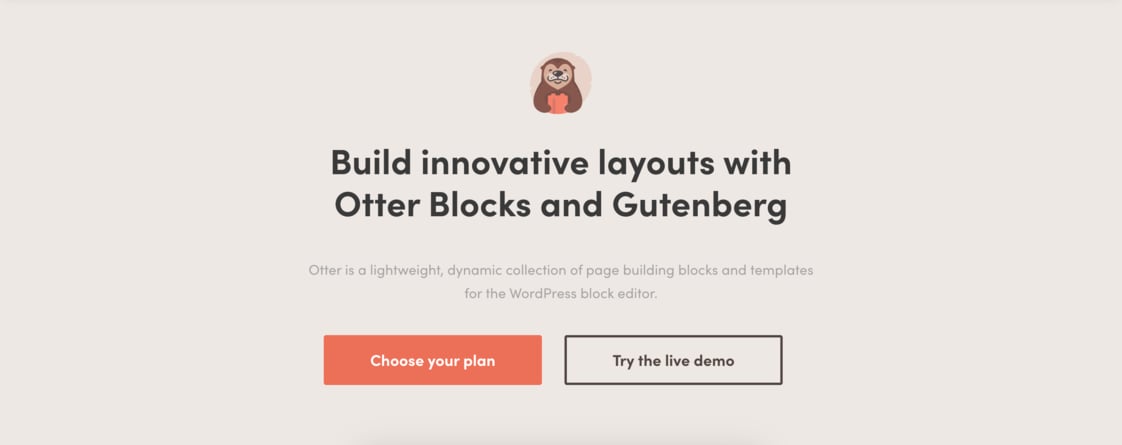
Otter Blocks is an easy-to-use plugin for any kind of WordPress website or blog.
This tool allows you to add dynamic content to your posts and pages using the block editor. You can insert WordPress content – such as the post ID, post date, and so on – as well as content from custom fields.
Regardless of whether you choose the free Otter or Pro Otter plan, implementing dynamic content with Otter Blocks is straightforward.
If you’re a beginner in the platform or aren’t code-savvy, you’re in luck: to use Otter Blocks, you don’t need coding skills!
Check out the following example on how to add dynamic values with Otter Blocks. To get started, go to the WordPress block editor and follow these steps…
Start typing where you want your dynamic content to appear and enter the % symbol. This will display a pop-up that shows a list of available dynamic content, including post data as well as an option for custom fields.
If you’ve installed a plugin like Advanced Custom Fields (more on that in a moment), you’ll also see that as an option on the list.
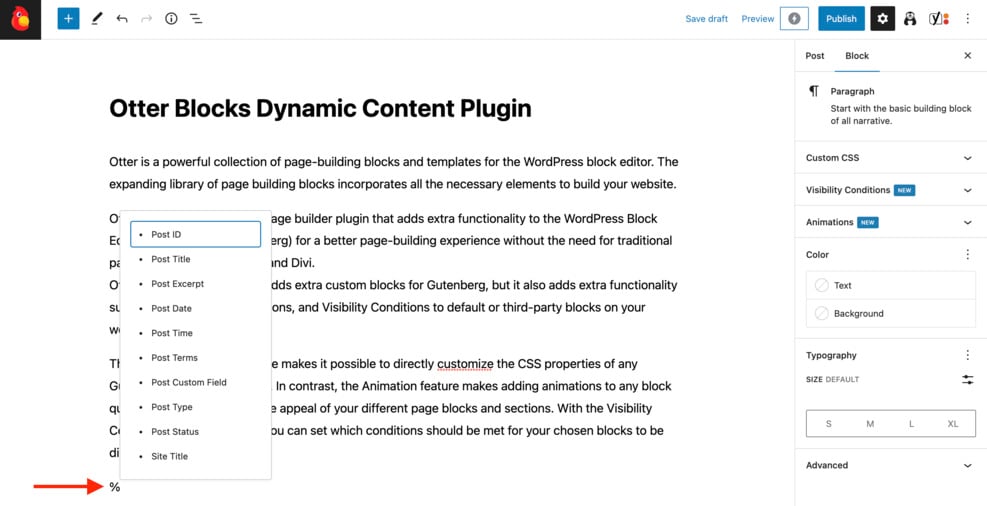
Once you’ve chosen one, click on it to customize it.
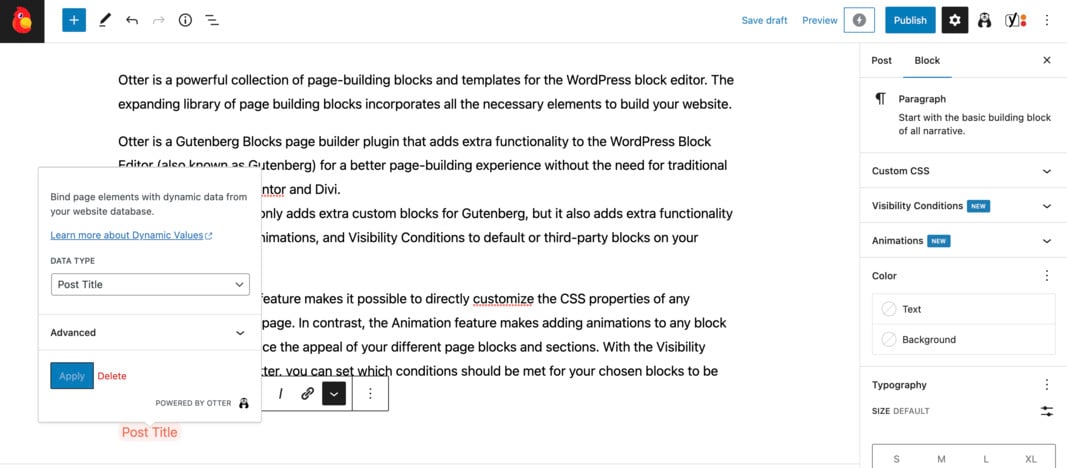
You can also add dynamic values by selecting a text, clicking on the 🔽 icon, and choosing “Dynamic Value”.
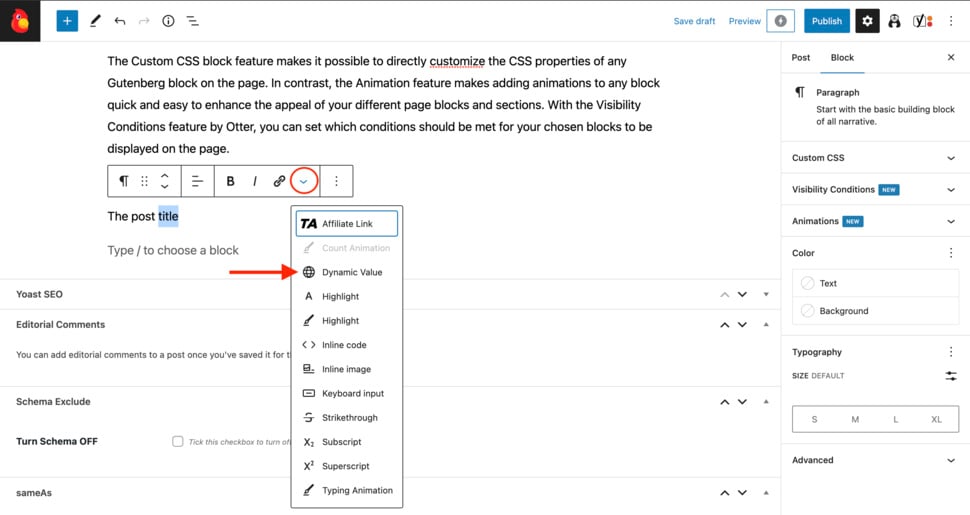
Choose a value and customize it.
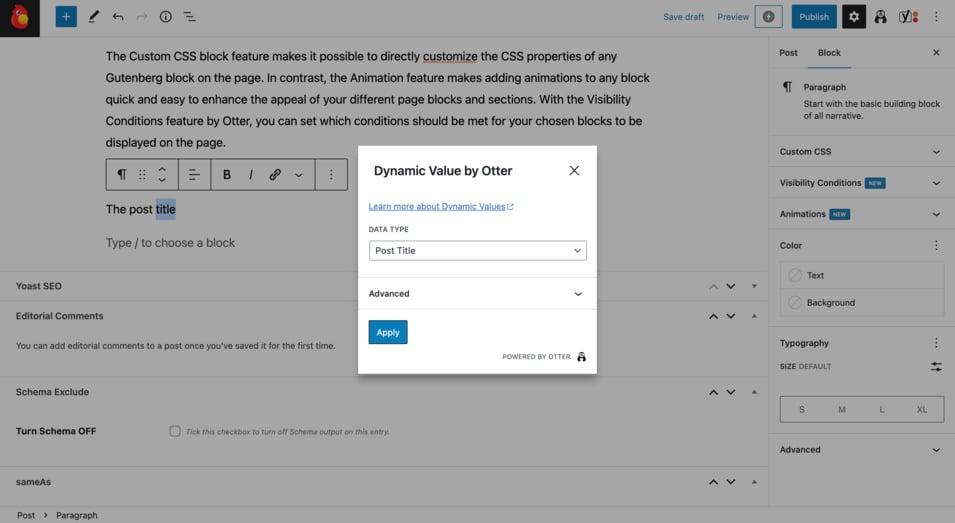
The dynamic values can import data and display changes on your site automatically. For example, if you insert the dynamic Post Date, that value on the frontend will automatically update if you ever change the post’s date in the backend.
With Otter Blocks, you can also add other dynamic elements like images and links to your WordPress site. These features allow you to create great testimonial pages and compelling call-to-action buttons, and that’s just the start of it.
⚙️ Key features
- No code or technical knowledge needed – you can do everything from the block editor.
- Insert dynamic content anywhere in the block editor – just type %.
- Supports inserting information from custom fields, as well as regular WordPress post data.
- Has a special integration with Advanced Custom Fields.
- Also supports dynamic images and links.
💵 Pricing
Otter Blocks is a freemium WordPress dynamic content plugin.
Otter Pro price starts at $49.
2. Advanced Custom Fields
If you’re a WordPress user, Advanced Custom Fields (ACF) is a plugin you need to check out.
With ACF, you can easily add custom fields to posts, pages, and other content types. This way, you get the chance to tailor your website’s content to your specific needs.
While a lot of developers use Advanced Custom Fields to insert dynamic content in theme template files, you also get several code-free ways to insert dynamic content from ACF fields:
- Shortcodes – to just display a single piece of content, you can use a shortcode.
- Otter Blocks – you can use the Otter Blocks plugin above to insert ACF fields in the block editor.
- Page builder plugins – plugins like Elementor Pro and Beaver Builder/Beaver Themer let you dynamically insert ACF fields in your page builder designs, including theme templates that you create with those tools’ theme builders.
What’s more, ACF provides a user-friendly interface that allows you to add and edit custom fields with options for selecting field types, setting default values, and configuring conditional logic.
ACF offers a free and a paid version of the plugin (ACF Pro). The main difference between both options is that ACF Pro includes more fields and functionalities like the Repeater Field (seamless solution for repeating content) and the Gallery Field (customized image galleries).
⚙️ Key features
- Over 30+ field types available.
- User-friendly.
- Extensive documentation and support guides.
- The Repeater Field, ACF Blocks, + five more extra features in ACF PRO.
- Insert custom fields using PHP in theme template files.
- Insert custom fields code-free using shortcodes, Otter Blocks, or page builder plugins.
💵 Pricing
ACF is a freemium WordPress dynamic content plugin. The free version should be fine for most users’ WordPress dynamic content needs.
If you need premium functionality, ACF Pro starts at $49 per year.
3. Pods
Pods is a powerful WordPress plugin that allows users to create custom post types, fields, and taxonomies easily. This dynamic content plugin provides a straightforward and user-friendly interface that makes it accessible for non-developers to create and manage custom content types for their website.
One of the key benefits of Pods is the ability to create custom post types. With this feature, you can easily create custom content types for different types of content on your website. For example, you can create a custom post type for a portfolio or team members with its custom fields and taxonomies.
Another helpful feature of Pods is the ability to create custom fields. This feature lets you add additional data to your posts, pages, and custom post types. With Pods, you can create various types of custom fields, including text fields, date fields, and image fields. You can also group custom fields into field groups for easier management.
Additionally, Pods allows users to create custom taxonomies, which are used to organize and categorize content. You can create custom taxonomies for your custom post types or use them with regular posts and pages.
To insert dynamic content from your Pods custom fields or taxonomies, you get a few different options:
- Shortcodes – you can use shortcodes to insert dynamic content directly in the editor.
- HTML templating – if you don’t feel comfortable using PHP, Pods offers its own HTML templating system that just requires some basic HTML and CSS to use.
- Page builder plugins – as with ACF, page builder plugins like Elementor and Beaver Builder offer dynamic content support for Pods.
Pods is a plugin for everyone. If you go to Pods documentation, you can learn how to use the tool straightaway, even if you’re a WordPress newbie.
With its user-friendly interface and top features, Pods is an excellent choice for anyone looking to take their WordPress website to the next level.
⚙️ Key features
- Supports custom fields, custom post types, and custom taxonomies.
- Has its own HTML templating system if you don’t feel comfortable using PHP.
- Insert individual field data using a shortcode or insert HTML templates using shortcodes.
- Helpful documentation adapted to every WordPress user.
- Integrates with third-party design tools.
💵 Pricing
Pods is 100% free.
WordPress dynamic content plugins compared
To make your life easier, we’ve created a table to compare the pricing and the best uses of each plugin.
| Plugin | Pricing | When to use it |
|---|---|---|
| Otter Blocks | Free / paid plans from $49 per year.
For more information, go to the Otter Blocks pricing page. |
Otter Blocks is a perfect tool for users who want to insert dynamic content in the block editor. |
| Advanced Custom Fields | Free / paid plans from $49 per year.
For more information, go to the ACF pricing page. |
ACF is an excellent solution for developers who want to add custom fields anywhere in WordPress. |
| Pods | 100% free. | Pods is designed for users who need to create and manage all types of custom content in WordPress sites. |
Get started with WordPress dynamic content today
If you’ve come this far, you’re prepared to use dynamic content and make your WordPress site more engaging and fun.
The possibilities are endless regarding what you can do with WordPress dynamic content.
For the simplest ways to test things out, you can use Otter Blocks to insert dynamic content in the block editor.
To level things up, you can pair ACF with Otter Blocks. You can create custom fields with ACF and then insert field data in the block editor using Otter Blocks – no code needed.
We wish you good luck 🤩 adding WordPress dynamic content to your website or blog. Enjoy the journey!